SE465: Software testing and Quality Assurance
Link to course notes here.
There are weekly assignments. So this might get really annoying.
Things that I need to review for final:
- Test smells (p.37 of Emily notes)
- what are the different integrations? and differences?
- Cluster integration (inter-class)
Concepts
Some basic terminology:
- A test fixture sets up the data that are needed for every test
- Example: If you are testing code that updates an employee record, you need an employee record to test it on
- A unit test is a test of a single class
- A test case tests the response of a single method to a particular set of inputs
- A test suite is a collection of test cases
- A test runner is software that runs tests and reports results
Fault vs failure vs error: See Fault
- Error is something that a user has written
- A fault is the result of an error
- An failure is what happens when a fault executes
There are 3 levels of software testing:
- Unit Testing
- Integration Testing
- test of group of related units together (ex: testing a group of related units together)
- System Testing
We have 2 approaches to testing:
- Blackbox Testing
- Testing without any understanding of the interior design of the code
- Whitebox Testing
We talk about how we can create a Control Flow Graph.
Code Coverage
Try to move to Code Coverage afterwards.
Then, we talk about different code coverage models:
- Statement Coverage
- Segment (basic block) Coverage
- Branch Coverage
- Condition Coverage
- Condition/Decision Coverage
- Modified Condition/Decision Coverage
- Path Coverage
Statement coverage = # of executed statements / total # of statements
Segment (basic block) coverage counts segments rather than statements.
branch coverage = # of executed branches / total # of branches
condition coverage = # of conditions / total # of conditions
- seems to exclude the else condition
- however, if you have condition/decision coverage, then you need to look at the branching
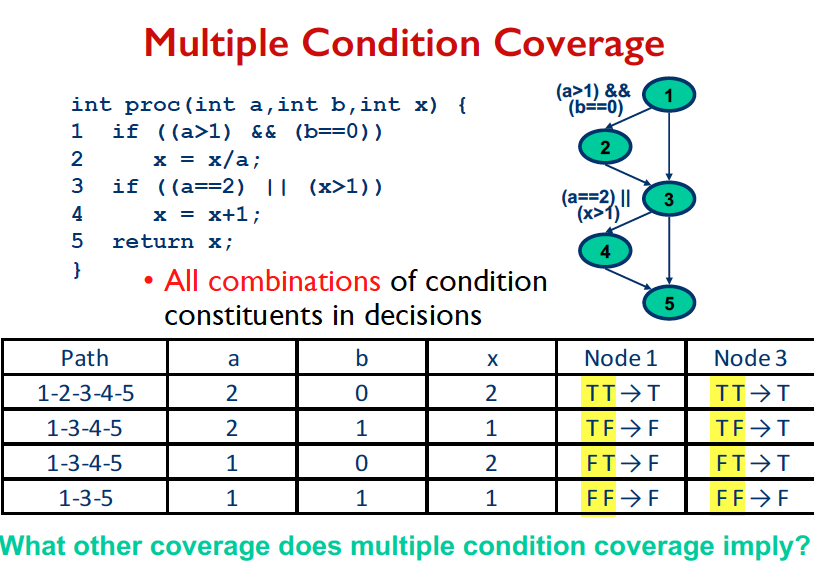
They talk about the short-circuit problem.
Modified Condition/Decision Coverage
- Key idea: test important combinations of conditions and limiting testing costs
Often required for mission-critical systems.
Each condition should be evaluated one time to “true” and one time to “false”, and this with affecting the decision’s outcome.
So then, we have group of variables changing. Ex for (a || b) && c
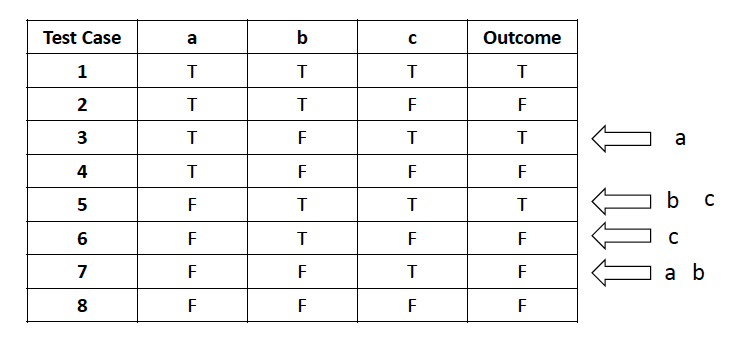
Path coverage is basically the same as branch coverage? Except, it’s looking at every single path. Branch coverage is entirely independent.
Loop coverage
- At minimum, we have to execute it zero times, once, and twice or more times
- To get the coverage, use these values: minimum +- 1, minimum, maximum, maximum +-1, typical
Need to understand that there are 2 uses:
- c-use (computational use)
- this is a vertex
- p-use (predicate use)
- This is an edge
We talk about Data Flow Analysis and Data Flow Graph.
du-pair = d + u thing
There is the du-path. Either one of 2 cases (so essentially, having c-use or p-use at the last node, don’t have a definition on the path excedpt maybe last node, you can’t have it repeat):
- c-use of v at node nk, and P is a def-clear simple path with respect to v (i.e., at the most single loop traversal)
- p-use of v on edge nj to nk, and <n1,n2,…,nj> is a def-clear loop-free path (i.e., cycle free)
For example:
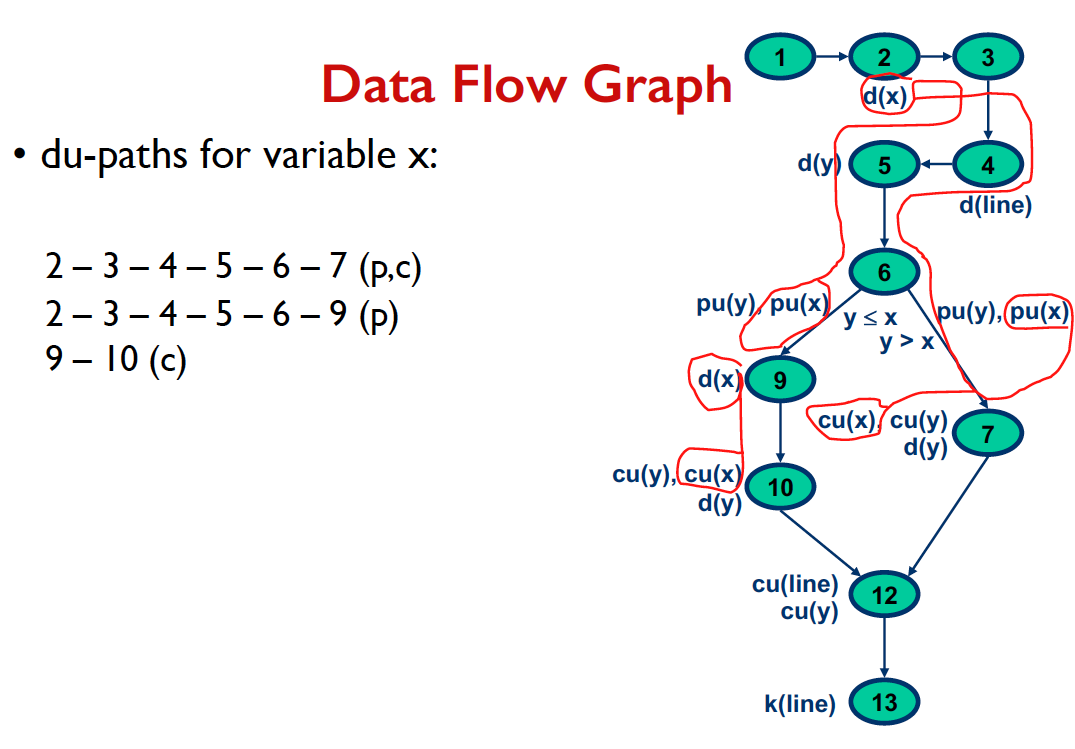
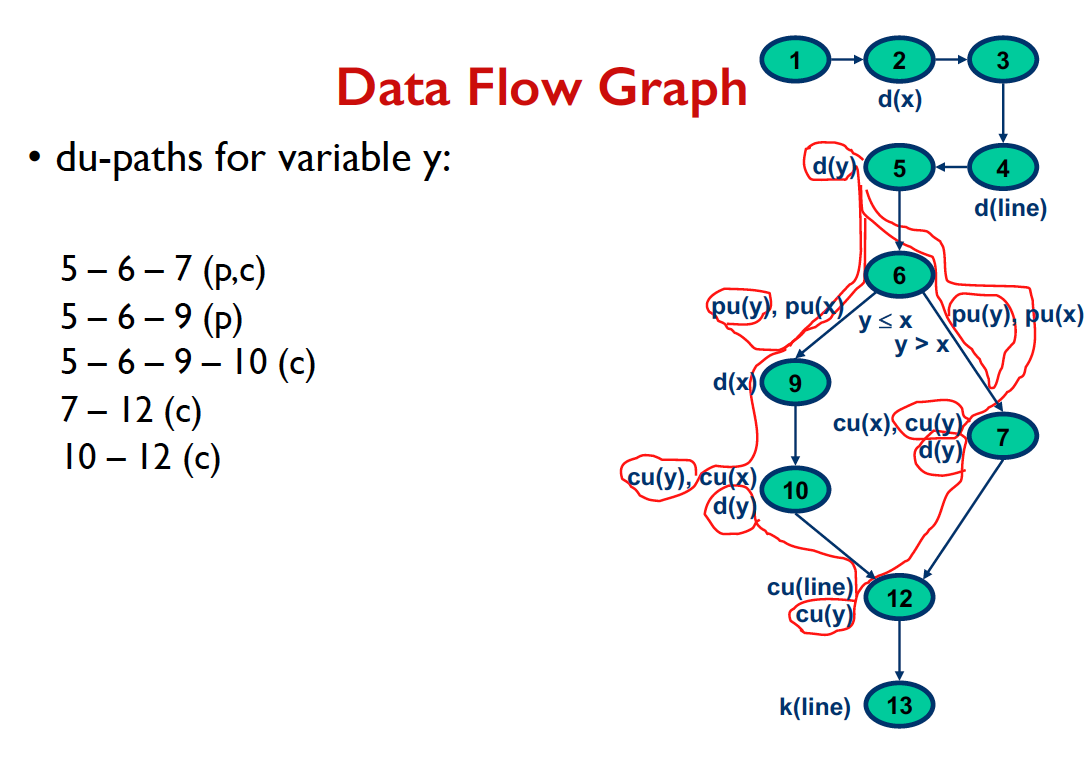
Then, we get into Mutation Testing.
There are 3 criteria that are spoken about:
Good test case:
- Reach the fault seeded during execution (reachability)
- Cause the program state to be incorrect (infection)
- Cause the program output to be incorrect (propagation)
Then, we talk about more general guidelines for testing.
They talk about all the different test smells:
- Mystery Guest
- when the test uses external resources, and thus is not self-contained
- Resource Optimism
- makes assumption about existence / absence of state from external resources
- Test Run War
- test code fails when multiple programmers are running them
- General Fixture
- Eager Test
- solution is to separate into tests that only test 1 method each
- Lazy Test
- several tests check same method using same fixture
- Assertion Roulette
- Indirect Testing
- For Testers Only
- Sensitive Equality
- Test Code Duplication
Then, we move onto integration testing.
Stub replace what are called modules.
Different strategies for integration testing:
- Big Bang
- Top-Down
- Bottom-Up
- no need for stubs
- Sandwich
- Risk-Driven
- integrate based on criticality
- Function/Thread-Based
- integrate components according to threads / functions they belong to
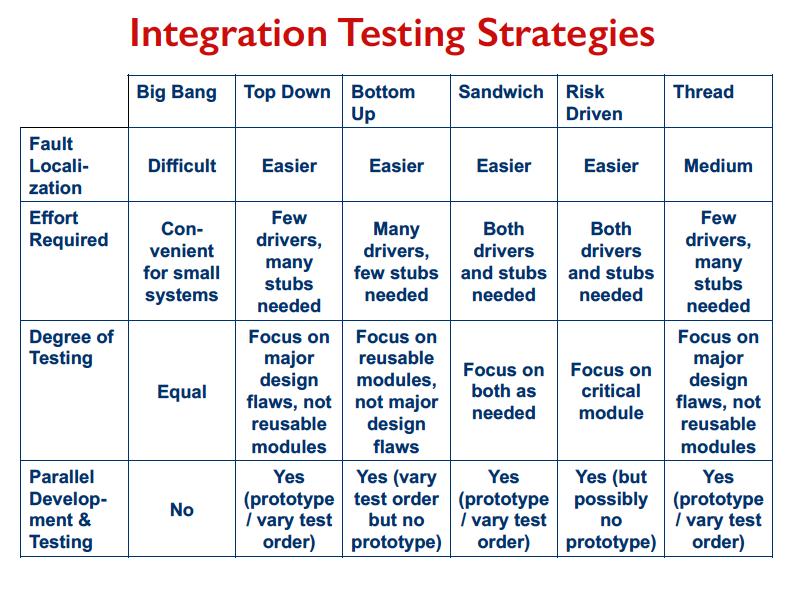
The professor then talks about testing for OO. The concerns are valid. The methods on their own don’t mean anything generally. And they depend on the state of the object.
There are many integration levels:
- Basic unit testing (intra-method)
- Unit Testing (intra-class)
- Cluster integration
Mocking and stubbing.
mock object = dummy implementation for an interface or a class in which you define the output of certain method calls
A Mock has the same method calls as the normal object
- However, it records how other objects interact with it
- There is a Mock instance of the object but no real object instance
stubbing = return the whatever value we passed in
Creating a mock
//Let's import Mockito statically so that the code looks learer
import static org.mockito.Mockito.*;
//mock creation
List mockedList = mock(List.class);
// Or @Mock List mockedList;We can then call verify on this mock object
mockList.add(“one”);
verify(mockedList).add(“one”);
verify(mockedList).add(“two”); //will fail because we never called with this valueExamples
when(mockedList.get(0)).thenReturn("first");
when(mockedList.get(1)).thenThrow(new RuntimeException());There’s the argument captor:
verify(mockStorage).barcode(argCaptor.capture());
//this line verifies the barcode function is called and remembers what is the input for the bar code function
verify(mockDisplay).showLine(argCaptor.getValue());
// to ensure the same values are called in both barcode and showLineCluster Integration.
They talk about the Object Relation Diagram (ORD).
- C = composition
- A = association
- I = inheritance
CFW = class firewall
Building a firewall is pretty easy
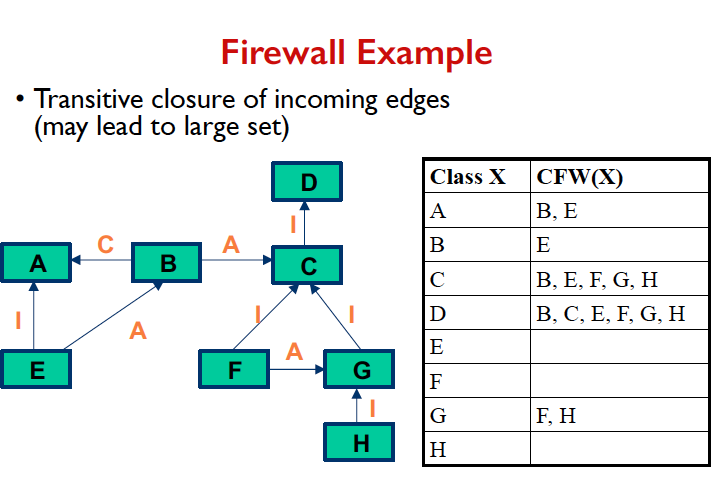
MADUM = minimal data member usage matrix
- Different usage categories: constructors, reporters (read only), transformers, others
nxm matrix and n is # data members, m is # member methods
Need to go through the steps of the diagram.
Next: We talk about data slices.
- The goal is to reduce the number of method sequences to test
I need to know how to use the MADUM table.
Blackbox testing
For each use case:
- Develop a scenario graph
- Determine all possible scenarios
- Analyze and rank scenarios
- Generate test cases from scenarios to meet coverage goal
- Execute test cases
Equivalence partitioning
Scenario graph Equivalence partioning decision table Category partitioning
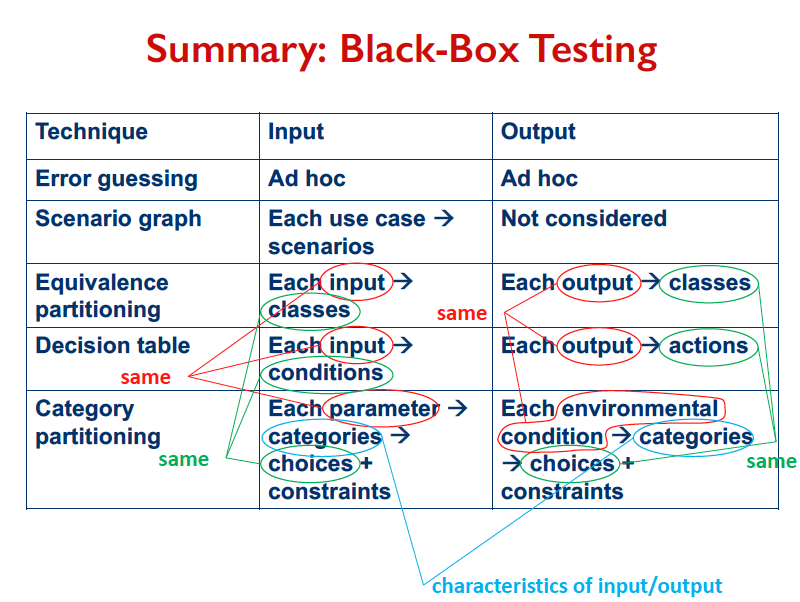
Fuzzing
Fuzzing: set of automated testing techniques that tries to identify abnormal program behaviors by evaluating how the tested program responds to various inputs.
2 main categories:
- Generation based
- Mutation based
Greybox fuzzing - Focus fuzzing on those that lead to higher code
Metamorphic Testing
generally to reveal new errors.
test-suite minimization, aiming to reduce the # of test cases while ensuring adequate coverage.
If a test requirement ri can be satisfied by one and only one test case, the test case is an essential test case.
- if a test case satisfies only a subset of the test requirements satisfied by another test case, it is a redundant test case.
- GE heuristic: first select all essential test cases in the test suite; for the remaining test requirements, use the additional greedy algorithm, i.e. select the test case that satisfies the maximum number of unsatisfied test requirements.
- GRE heuristic: first remove all redundant test cases in the test suite, which may make some test cases essential; then perform the GE heuristic on the reduced test suite.
Regression testing
Delta Debugging: A technique, not a tool
The inverse delta i fails, and that causes the entire test to fail.
Software Reviews and Inspections
Then, we get onto software reviews and inspections.
planning → overview → preparation → meeting → rework → follow up
Number of code errors (NCE) vs. weighted number of code errors (WCE)
The teacher introduces 3 types of metrics:
- Process Metric
- Product Metrics
- Project Metric
Process metric focuses on error density, and timetable metrics. Error removal effectiveness, and productivity.
– classic measure of the size of software by thousands of lines of code
FP = measure of development resources required to develop a program, based on the functionality specified for the software
Refactoring
2 types:
- Floss refactoring (interleaved refactoring)
- Root canal refactoring (massive changes)
Slice based cohesion
Tightness = S/length(M)
3/15
It expresses the ratio of the number of statements which are common to all slices over the module length
overlap = 1/VO sum * sum(slice / sum count of variables) t expresses the average ratio of the number of statements which are common to all slices to the size of each slice.
Clone detection
Type 1: Code fragments are identical Type 2: structurally and syntactically identical Type 3: fragments are copies with further modifications type 4: two or more code fragments perform the same computation, implemented through different syntax
- ex: 2 different sorting algorithms
Logger
Load Testing
two ways to schedule workloads:
- steady load
- stepwise load
Chaos engineering
A chaos Monkey randomly disables production instances to make sure that the system is robust enough to survive this common type of failure without any customer impact.
latency monkey introduces artificial delays
View
FFF → F TFF → T FTF → T FFT → T
in top down, need a lot of stubs. Favorizes testing for high level design flaws, whereas bottom-up favors testing the functionality of reusable components more thorougly.
There’s inspection, walkthrough and buddy check.
Midterm review
- a
- c
- b
- c
- a
- b
3/5 0/3 1/4 3/5 0/3 1/4 3/5 0/3 1/4
4.1 I misread. Use a number that is not max int 4.2. Dataflow graph has the 3 d(n), d(num) d(sum) d(i) pu(i) pu(n)
cu(num), d(number)
cu(num), cu(number), d(sum)